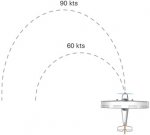Space combat in ED is basically energy fighting. You want to maintain an energy advantage over your opponent at all times. In essence, you're trying to dictate the entire battle as much as possible by playing to your strengths, and against your opponents.
Low or no pips in ENG means your max velocity is lowered significantly. It also means your corner speed is much lower (the blue area.) What that equates to is you travel less distance when you make a sharp turn. You can make sharp turns because your radius for turning is significantly less than if you were running with many pips in ENG. The downside is, the lack of velocity also means it's easy to counter your movements because there's little orbit or slide in your movements. Another downside of low pips in ENG is that it also lowers your thruster threshold. When you apply lateral thrusters, it lowers your max velocity. You aren't slowing down. Rather, your velocity vector is changing. The HUD doesn't display this. You can see this for yourself. Fly in a straight line with max throttle then apply and hold thrusters in a particular direction. One of the major disadvantages of this is that you can effectively drop to a standstill in a tight turn and have to suddenly reverse. This can leave you in a very vulnerable situation. It happens with high pips in ENG as well, but you have more leeway because your sliding has more momentum.

On the opposite end of the spectrum is high pips to ENG. This increases your max speed, your corner speed and so on. The advantage to this is that your turns are wider and will cause you to slide around while using thrusters. This is essential if you want to orbit and out maneuver a big ship that's pivoting quickly. The trick is managing your speed because it'll fluctuate quite a bit. It's easy to overshoot, but also easier to stick in a blind spot at close range due to momentum. That momentum is what causes you to slide. It's quite easy to see with Flight Assist OFF, but it happens with Flight Assist ON as well. The main difference is that with FA ON, your ship's computer automatically compensates for your control movements. That takes time, especially with higher momentum. You can use this to simulate very brief moments of what it's like with FA OFF and incorporate that into your flying. Naturally the more maneuverable and responsive a ship and it's thrusters are, the smoother it will be.
Another point is booster usage. With low ENG power, boosts have a lower velocity and take less time to wind up, and wind down. It's easy to control and you travel a shorter distance. This is actually perfect for chasing a large target, or using it to do a quick boost accelerated turn in a dogfight without overshooting. High ENG power is harder to manage close in and works better for chasing something down, or closing range. It can also be used for evasive maneuvering (pitch, roll and yaw + thrusters) to tone it down to a more manageable level. This can cause a power slide which might put you in a worse position than you were in, such as setting you up for a head to head situation.
There's also another factor involved. Knowing when to reverse your turns. Some ships have great visibility and you can track your target's movements pretty easily with the good old Mark I Eyeball. Some don't though, and this is where the target display on the HUD comes into play, as well as the radar. You can always see what the target's orientation is to you based on the display and then judge where it is based upon the radar. Secondly, exhaust trails. Ships leave these as they're flying around. They make a good quick visual cue to go along with the HUD display. It takes practice but it's doable. Combine that with head tracking and you can generally tell when you need to reverse a turn or alter your thrust vector to counter the NPCs movements. Timing is crucial. It's also different for each ship due to handling characteristics, as well as what opponent you are facing. Some ships have better yaw than pitch (type 7 for example), and that has to be taken into account as well.
For the Asp because it's sluggish, it'll take considerably more practice to learn to fly super well.
[video=youtube;6jFfl1qLHP0]https://www.youtube.com/watch?v=6jFfl1qLHP0[/video]
Edit - Forgot to mention. An A Rated Asp runs 45m+ and can still perform Exploration duties with a 26ly range. More or less depending on armor.

